|
February 2009
Istanbul, Damascus, Amman, Petra
Land Travel
Istanbul
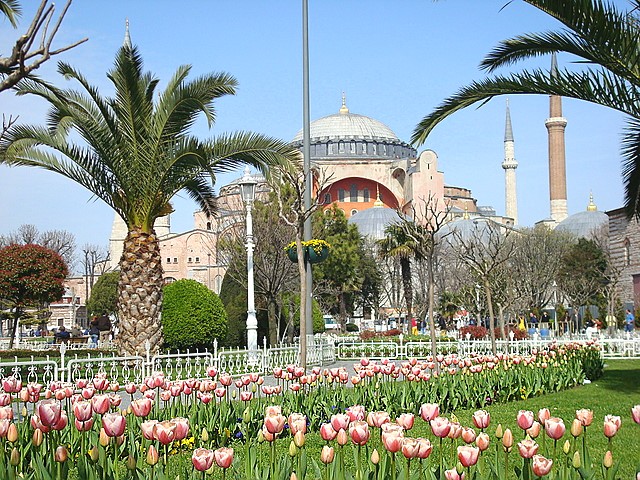
We endured the overnight bus ride to Istanbul and upon arriving at the immense otogar (bus terminal) we were directed, quite by accident, to a Metro
bus that took us to Askay an area of town where according to Rene's notes we should be able to catch the tram. The bus driver unloaded us and gave us directions to the tram and all at no charge since the driver wouldn't accept our money. We hopped the tram to the Sultanahmet station where we disembarked in search of a hotel. After trudging through the Hippodrome, the scene of chariot races during Byzantine times, we settled into the Turkoman Hotel not for any reason other than I refused to carry the luggage any further in the cold and rain.
For the next three days we hiked around visiting the Basilica of Hagia Sophia (Holy Wisdom), Archaeological Museums, Museum of Turkish and Islamic Art, Topkapi Palace, Blue Mosque, Hippodrome, Spice Bazar, Grand Bazar and strolled by many of the historical landmarks viewing the opulence of the Byzantine and Ottoman Empires. We, as cruisers, may not be so scholarly inclined as to visit that many museums in three days but the weather was miserable and we were limted to indoor activities. For us the Archaeological Museum proved to be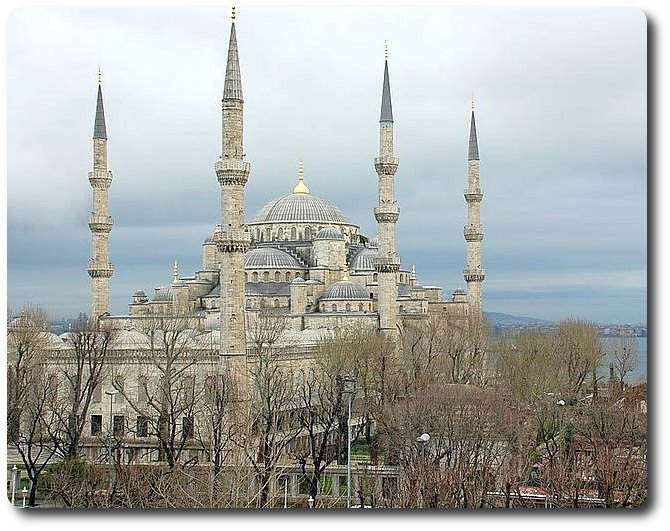 the most impressive. Most of the artifacts were uncovered and sent to Istanbul during the period of the Ottoman Empire when the empire stretched from the Balkans through most of the Middle East and into northern Africa. The treasures included items from Greek, Roman, Assyrians, Egyptian, Lycian, Hittite and many more cultures. If you think of Turkey as being next door to the Tigris and Euphrates Valley and as the land bridge between east and west you can see how the collection of the conquers and the conquered can extend well beyond the boarders of what is now Turkey. The museum is located on the park like grounds of the Topkapi Palace and the collections on display when we visited were mostly from the Greek and Roman periods. We were most impressed by the display of cobalt wall tiles from Babylon and the sarcophagus of Alexander the Great (Alexander was not buried in this tomb and his burial site has yet to be discovered) excavated from Sidon, Lebanon. the most impressive. Most of the artifacts were uncovered and sent to Istanbul during the period of the Ottoman Empire when the empire stretched from the Balkans through most of the Middle East and into northern Africa. The treasures included items from Greek, Roman, Assyrians, Egyptian, Lycian, Hittite and many more cultures. If you think of Turkey as being next door to the Tigris and Euphrates Valley and as the land bridge between east and west you can see how the collection of the conquers and the conquered can extend well beyond the boarders of what is now Turkey. The museum is located on the park like grounds of the Topkapi Palace and the collections on display when we visited were mostly from the Greek and Roman periods. We were most impressed by the display of cobalt wall tiles from Babylon and the sarcophagus of Alexander the Great (Alexander was not buried in this tomb and his burial site has yet to be discovered) excavated from Sidon, Lebanon.
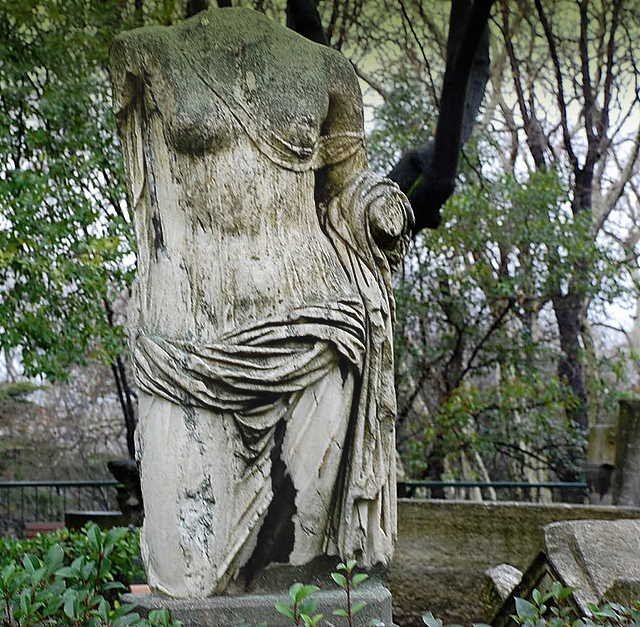
The hotel Turkoman is well located and provides a spacious room for a winter rate of around $60 USD per day. In fact it is so close to the Blue Mosque that the windows rattle five times a day during the muezzin or "call to prayer" which is broadcast over the loud speakers located high on the six minarets. Wherever we go we search for locally owned and operated hotels avoiding the overpriced chains that remind us of a night in Des Moines. We enjoyed walking the streets and talking to the restaurant touts, asking them what was good and listening to them explain how delicious each dish was. The days were wet and gray and to warm up we ordered lentil soup at every restaurant we entered. The recipe was always different but we learned it was best served with a twist of lemon.
There were small groups of tourists or travelers from Western Europe, Asia and the Middle East and even a few Americans were up for the experience. People on the street were very friendly and opened each conversation asking us where we were from and welcoming us to Turkey. These small encounters always ended by our new acquaintances asking us if we had bought our carpet yet. When we explained that we lived on a boat, we lost our luster but the determined merchant would ask if our mother-in-law had a carpet. All was good during our stay and in order to embrace the Turkish experience more fully, Rene boldly volunteered to have a Hamam or Turkish bath in the company of a group of English ladies we met at the Turkoman.
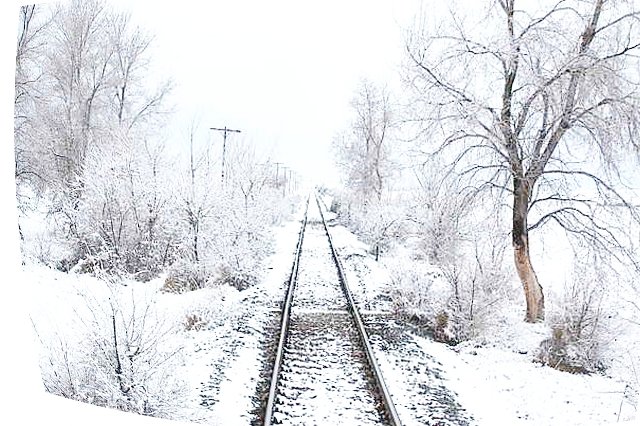
After three nights we had our bags packed and were ready for more. Upon returning to Turkey in January, Rene and I carried newly issued passports since our old ones were full and were to expire within a year. The new design with a heavily imprinted background make them more difficult to use but it's kinda like having a new baseball glove, you need to break it in before it becomes comfortable. So we booked a train to carry us across Turkey to the border of Syria where we hoped to continue on to Jordan. Before heading off to Syria we checked the US State Departments web site to see if there were any travel advisories and sure enough Syria was on the list but hey so was Sri Lanka, Eritrea, Sudan, Egypt and Colombia. Countries that comprised some of our most memorable adventures. Well, we have been forewarned but at the same time we read that the Obama administration is about to lift the sanctions on Syria, so we were off.
Below are a few of our pictures but if you would like to look at all of them then just click on the smiley face and it will take you directly to our Istanbul set in Flickr. Enjoy! 
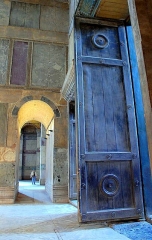 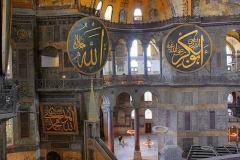 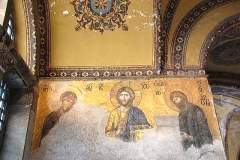
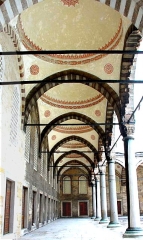 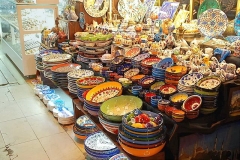 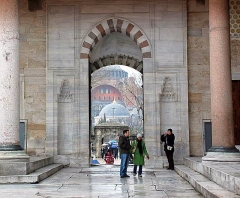
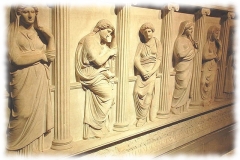 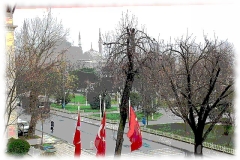 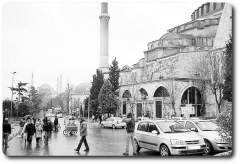
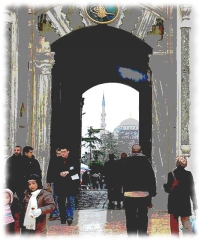 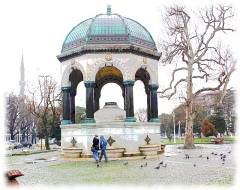 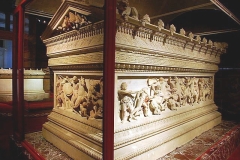
Midnight Train to Georgia (Jordan)
We departed Istanbul on a TCDD train headed for Adana, Turkey which is the point furthest southeast that the train runs. Our private compartment, equipped with two berths, was new and was perfect for the 20 hour trip. 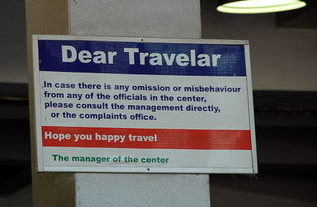 The train would not be traveling in a direct route but that gave us more of an opportunity to see Turkey. We departed on time at 2330 (almost midnight) and soon were tucked in for the night. The next day we were in snow fields for hours on end, interrupted only by small towns where a single minaret marked the location of the mosque. We read books and played cards and just enjoyed watching the snow come down. The dining car offered a limited selection but then again we were the only people using it. The train trip ended at 2000 and we dashed across the street from the train terminal to find a suitable hotel for around $40 USD. The next morning we taxied to the bus terminal and headed off to Antayla where we would change buses for one headed to Damascus, Syria. At the Syrian boarder we were detained since we didn't have a visa. Our scant research on the trip had led us to believe that we would be issued a VOA (visa on arrival) but it didn't say how long it might take. We had talked about getting a visa while in Istanbul but for some reason didn't. The train would not be traveling in a direct route but that gave us more of an opportunity to see Turkey. We departed on time at 2330 (almost midnight) and soon were tucked in for the night. The next day we were in snow fields for hours on end, interrupted only by small towns where a single minaret marked the location of the mosque. We read books and played cards and just enjoyed watching the snow come down. The dining car offered a limited selection but then again we were the only people using it. The train trip ended at 2000 and we dashed across the street from the train terminal to find a suitable hotel for around $40 USD. The next morning we taxied to the bus terminal and headed off to Antayla where we would change buses for one headed to Damascus, Syria. At the Syrian boarder we were detained since we didn't have a visa. Our scant research on the trip had led us to believe that we would be issued a VOA (visa on arrival) but it didn't say how long it might take. We had talked about getting a visa while in Istanbul but for some reason didn't.
Well anyway we were hoisted off the bus, luggage and all, and taken to a Baath military officer dressed in a dark green uniform and looking like Sadam Hussein of old. Photo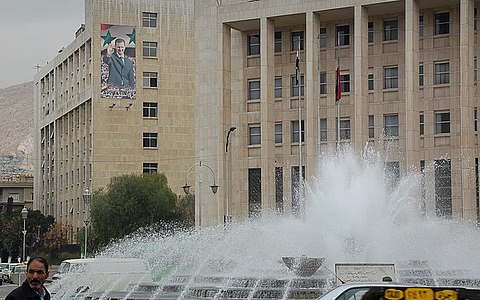 copies of our passports were taken and faxed off to Damascus. We were asked to wait in a cold lobby that looked like something out of the Stalin era and our bus then left without us. We were living the movie Terminal. copies of our passports were taken and faxed off to Damascus. We were asked to wait in a cold lobby that looked like something out of the Stalin era and our bus then left without us. We were living the movie Terminal.
After two hours we were issued a visa but couldn't pay for it since the bank on the Syrian side would not accept Turkish Lira. Someone saw our plight and offered to exchange money for a healthy commission. With visas now in hand and with about $16 USD in Syrian pounds as our only cash, we looked for a ride to Damascus some four hours away. Rene talked to a bus driver about a ride and he asks for $50 USD per person. Rene negotiated the price down to $16 USD for both of us. This was the best example of price elasticity based on seat availability we can remember. We boarded the bus and pulled up to customs where everything was taken off the bus. We then discovered that we were on a bus loaded with "smugglers“. Everyone had large shopping bags loaded with salt snacks. The customs officials were rummaging through the Frito Lay products and everyone was laughing and eating potato chips, taco chips and pretzels. The bus had been waiting for four hours to clear the border and it was another hour to clear the chips. Soon all was good and customs was paid and we drove about 15 minutes stopped and unload most all the passengers and chips. Among the remaining passengers there was a hig
h degree of camaraderie and even though we were penniless we made new friends that were willing and even anxious to help us. With their help, we were checked into the Palmyra Hotel and were enjoying a wonderful French meal at the Al Kamala by 2330. Although there is a great deal to see in Damascus, we decide to travel on to Jordan. We arrived at the station the next morning around 0830 to find that the buses to Jordan were "finished" meaning there were no more buses today. To avoid this small calamity, the "chief" of the terminal suggested we take a private car. In a rush of people talking to us all at once in broken English, a lady stepped forward. Nalia Maddox offered to "take care of us" and that is just what she did. We shared a vehicle with Nalia and she guided us through shopping, customs, immigration, duty free, a hotel search and arranged a tour of the area with a private car for the next day. We had a great chat with Nalia on the drive and she answered many of our questions about the area. Ruba, Nalias' daughter, picked us up from the taxi drop and deposited us at the Bristol Hotel where she had booked us a room using her corporate discount. Nalia and her four daughters will visit the US next year and our hope is that should they ever need any assistance that someone will come to their aid as completely and graciously as Nalia came to ours. We only wish that we could have spent more time in Amman to enjoy her company and somehow reciprocate. She is indeed "the good Samaritan".
That night we dined at Whispers, a must for any international visitor to Amman, and the next day visited the Dead Sea and Mount Nebo. The Dead Sea is landlocked between Israel and Jordan, and lies some 1,300 feet below sea level—the lowest elevation and the lowest body of water on the surface of the Earth. Because of its location on the contested "West Bank" (the Jordanian-Israeli frontier), its shores are nearly deserted, and permanent establishments are rare with the exception of a few hotels and tourists stops close to Amman. There is no beach but still it cost us $31 USD to view the swimming pool and watch a few people float in the Dead Sea on a cold day. It was less of an experience than we had hoped for. The Dead Sea is fed by the River Jordan but since a great deal of this fresh water has been diverted for agricultural purposes the Dead Sea is losing about a meter in depth each year. If this keeps up in about three hundred years you should be able to see the ruins of Sodom and Gomorrah which is believed to be at the bottom of the Dead Sea. (Note, the Great Salt Lake in Utah is about five times larger then the Dead Sea) The Dead Sea is landlocked between Israel and Jordan, and lies some 1,300 feet below sea level—the lowest elevation and the lowest body of water on the surface of the Earth. Because of its location on the contested "West Bank" (the Jordanian-Israeli frontier), its shores are nearly deserted, and permanent establishments are rare with the exception of a few hotels and tourists stops close to Amman. There is no beach but still it cost us $31 USD to view the swimming pool and watch a few people float in the Dead Sea on a cold day. It was less of an experience than we had hoped for. The Dead Sea is fed by the River Jordan but since a great deal of this fresh water has been diverted for agricultural purposes the Dead Sea is losing about a meter in depth each year. If this keeps up in about three hundred years you should be able to see the ruins of Sodom and Gomorrah which is believed to be at the bottom of the Dead Sea. (Note, the Great Salt Lake in Utah is about five times larger then the Dead Sea)
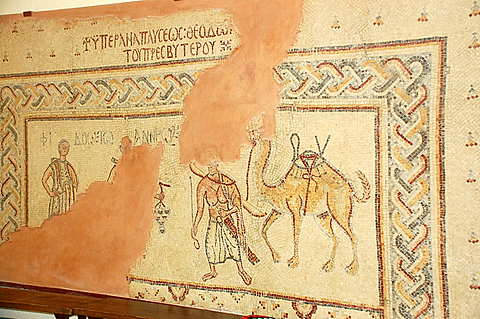
We then traveled on to Mount Nebo, the location where Moses saw the "promise land" before dying. The original church that was built on the site is being restored by Franciscan Monks and only a few of the historic mosaics were available for viewing.

After two nights of luxury in the Bristol Hotel in Amman, we were back on a bus at 0630 and headed for Petra. We were told that this is the only bus for the day but we later learned that this was the only "tourist bus" for the day but that in fact local buses run until about 1400. In Petra we schlepp our bags to the Petra Palace Hotel and then headed off to a most amazing archeological site. This area of the Arabian Peninsula controlled a great deal of the trade from China and India to the Mediterranean. The Nabataeans carved a city into the cliffs and hillsides from the tariffs they charged the caravans traveling the "silk road". The site can only be reached by traveling through a mile long very deep and narrow gorge of stunning stone walls which are carved with water gutters to reduce the flash flooding which would wash out the cobble road in the bed of the valley. The first large site that reveals itself was Al-Khazneh the gem of Petra. This tomb was carved in the 1st century BC and is the most well preserved at the site. As we continued to wander through the ancient city we found a large amphitheater capable of seating 7000, a plethora of tombs, a theater, temples, and ancient commercial streets and at any point you can see carvings that are only now being uncovered and deciphered. Since the Nabataeans believed in an open society you can see the influence of the Assyrians, Greeks, Romans and Egyptian cultures at the site. The Romans finally conqured The Nabataeans and Petra become part of the Roman Empire. Only the pictures can describe the beauty of this ancient city. To visit the area we walked up and down rough terrain for about six hours although at anytime we could opt for a ride by camel, donkey, cart or horse. The "wranglers" told us that their donkeys came with air conditioning and leather seats. We were thankful it was winter and therefore cool and less crowded and also for the Crown Plaza restaurant at the end of the trail where we enjoyed a beer before heading back to the starting gate.
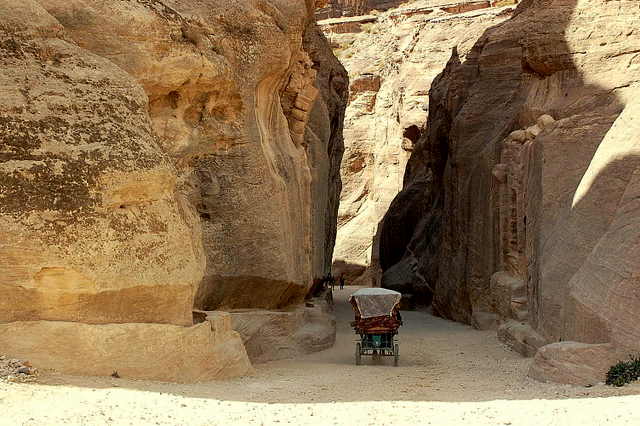
The site certainly makes our top seven archeological sites in the world and we hardly knew about it while we traveled up the Red Sea.
"On to Aqaba"
Remember the scene in Lawrence of Arabia where Peter O'Toole playing T E Lawrence, mounted on a white steed, shouts at his Arab troops "on to Aqaba" waving his sword: well we decide to skip the last leg which would have taken us to Aqaba but here's a quick reminder. Lawrence was a young British archaeological post graduate student working in Syria and Jordan and knew the area well before WW I. He eventually became a British officer and military advisor to the Arabs who were fighting the Ottomans to free the Arabian Peninsula. The Ottomans were allied with the Kaiser and therefore in helping finance the revolt, the British were in effect fighting the Germans. Lawrence' knowledge of the language and topography made him invaluable and his exploits were well documented and romanced by American Lowell Thomas and in his own writings.
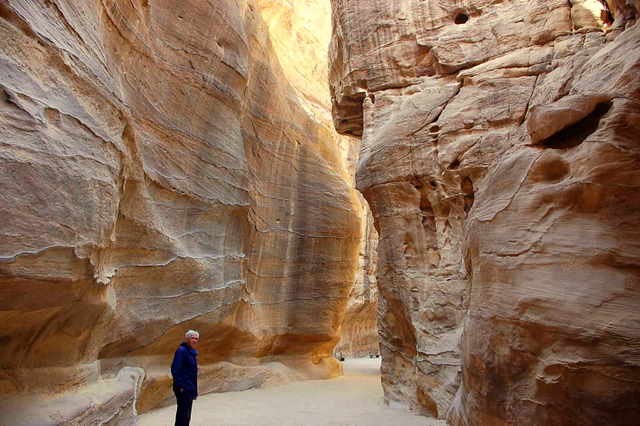
Departing from Petra by local bus, we headed north. Like in many areas of the world buses depart when they are full not on a time schedule. Arriving back in Amman, we jumped in a taxi and headed to the bus station on the north side of town but instead ended up at another taxi stand where we were told there were no more buses to Damascus that day however there was a private taxi that would take us. This is part of the unknown in the equation of this type of travel and if you feel that you are being cheated or taken advantage of it is probably not your cup of tea. Anyway we shared a cab with two Syrians and headed to Damascus. For some reason we couldn't enter the boarder crossing area until 1500 and actually killed some time at the nearby smuggling stores, or at least to us they appear to be smuggling store. We arrived two minutes early and the guard asked us to wait until 1500. A few minutes after three we arrived at immigration to find that our reentry slips were invalid and we needed to wait for a new visa, since the one from three days ago is now void. Our taxi left without us and we were again stranded at the Syrian border. There were two Americans and one Canadian also waiting for their visa in this much more modern facility. The young Canadian fellow was issued a visa immediately upon arrival but he was waiting on his friend an American who had already been waiting for three and one-half hours. It took about two hours for our visas to arrive and they all came in a batch so we were now, all of us, ready to travel. Now this border hassle is inconvenient for sure but just for a minute imagine you are a Syrian at the Canadian border and you want to enter the US. The process wouldn't take hours but rather weeks or months. You would have to prove financial capabilities and probably go for a personal interview. So you see for us this is a small inconvenience. It might however been an insurmountable obstacle if we had an Israeli visa stamped on our passport. During our trip to Syria and Jordan we never saw the state of Israel on any map and people only spoke of Palestine when referring to the area west of where we were.
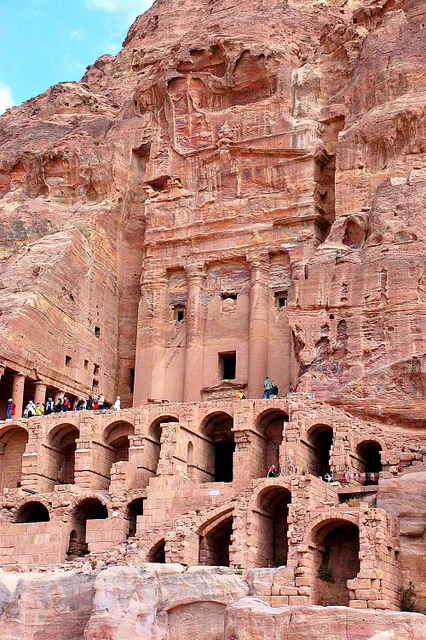
Well anyway, we spotted a van at the check point and Edward, the other American waiting with us and who speaks Arabic negotiated passage for all of us. Edward is a 40 year old graduate of Earlham College in Richmond, Indiana, imagine that. Upon arriving in Damascus we had two options. One was to return to the Palmyra Hotel for the night and treat ourselves to another wonderful meal and the other was to continue traveling. We opted to continue just to see if we could make a connection since we could always go back to the hotel. At the bus terminal, we found a bus leaving for Antakya, Turkey. Within two hours we were again heading north. During the trip we hit a snow storm and suddenly there were snow plows, cars spinning, a large bus in the ditch and a number of accidents. All this bedlam didn't cause our driver to hesitate. No, he "plowed“ on at full speed. At the Turkish boarder we zipped through because our Turkish multiple-entry visa was still valid. We were fortunate since we were out of Turkish Lira and at 0200 the bank was closed.
After arriving in Antakya at 0400, we caught a bus for Adana after a prolonged negotiation. The agents wanted to sell us passage on a direct (?) bus to Fethiye but we would have to wait 12 hours to catch it. No way, we decided to head to Antalya and take our chances. Within the hour we were underway and best of all it was during daylight hours. The road follows the coast line and on the map it is portrayed as a four lane express highway. In fact the majority of the road is a winding two lane street under construction with too many hairpin curves to remember. The curves are so sharp that vehicles from opposite directions cannot enter at the same time. The rugged coast line is covered with pine trees and every flat piece of land supports hot house agriculture. Cherry trees were blooming and the sun was warm and the day dry, one of the few we have had in the last two weeks. But around the next curve and up the hill and we were again in snow. As we neared Antakya the road widened and straightened thanks to a number of very long tunnels.
Finally we made the last bus change and were headed to Fethiye. We arrived at 0330, it had been 44 hours since our departure from Petra. In Fethiye it was colder than it had been when we left and the snow had worked its way down the mountain side. We were of course exhausted. But all's good with the boat and we cranked up the heater and slept until 1100.
Land travel can offer as much adventure as cruising. Instead of waiting for weather you might be waiting for transportation. We undertook the Syrian and Jordanian legs of this trip without guide books such as the Lonely Planet or Eyewitness Travel Guides. We did our research of these areas while underway by asking people and without a specific plan we enjoyed the visit more. Tourists travel to destinations with a plan, reservations made and research done: travelers feel their way along and adapt to the flow in many ways like cruisers. In the beginning this journey was about learning more about the area and checking another box on the scorecard of places visited but it ended up about the people we met along the way.
It was a great trip and sitting on the boat today we reflect upon the people we met, the sites we visited and our broader knowledge of the area and think there may be time for one more trip before spring comes.
Please click on the "smiley face" to see the Flickr set of Jordan, Dead Sea, and Petra. 
To view the slide show of a few of our pictures click on the arrow below.
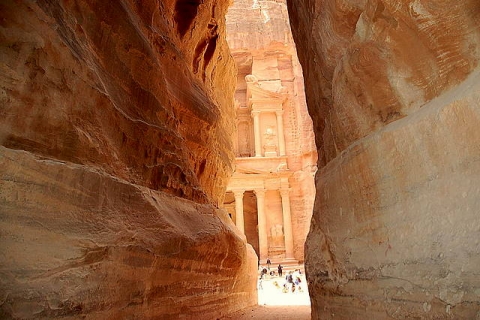
| |
  
|
A Glimpse of Al-Khaznet (Treasury)
|
If you're headed our way:
- Here are some tips should you ever consider traveling by bus in this area of the word. First carry a number of different currencies. Unlike airports, bus terminals do not have ATMs. Carry small change because you will need it for the toilets. Restrooms (W. C.) have an attendant and they may charge from .25 to .50 to .75 USD but it is money well spent for a clean facility with a western style toilet and paper products (which you should always carry yourself just in case).
- Get a visa before you head to Syria
Back Next
|